Banknotes of the rupiah
The first paper money (banknotes) used in the Indonesian archipelago was that of the United East Indies Company, credit letters of the rijksdaalder dating between 1783 and 1811. Netherlands Indian gulden government credit paper followed in 1815, and from 1827 to 1842[1] and again from 1866 to 1948[2] gulden notes of De Javasche Bank. Lower denominations (below 5 gulden) were issued by the government in 1919–1920 and 1939–1940, due to wartime metal shortages, but otherwise day-to-day transactions were conducted using coinage.
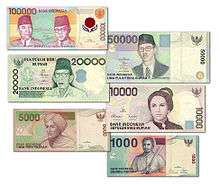
.jpg)
.jpg)
.jpg)
Gulden notes were issued by 'The Japanese Government' during the occupation from 1942, becoming 'roepiah' in 1943.
The first truly Indonesian rupiah notes, however were issued in 1946, during the war of independence with the Dutch, following the unilateral declaration of independence by the Indonesians at the end of World War Two on 17 August 1945. This money is known as 'Oeang Republik Indonesia' ('oeang' being the old spelling of 'uang', in English 'money').
Following the negotiated peace treaty in The Hague of 1949, the 'ORI' was withdrawn, to be replaced by an internationally recognised 'Indonesian rupiah'.
The Indonesian rupiah has been subject to numerous devaluations, and in 1965 existing paper was withdrawn, replaced by a new currency at the rate of 1000 to 1.
Money around independence year
Series 1, '1945'
The first 'Indonesian rupiah' bank notes bore the date of the proclamation on new Indonesian money, 17 October 1945, under the authority of the "Republik Indonesia", and were apparently intended for issue on 1 February 1946, but due to the capture of most of the notes, only a tiny number escaped at this time.
The circulation began in earnest in Java from 10 October 1946. The notes were in denominations of 1, 5, and 10 sen notes, plus ½, 1, 5, 10, and 100 rupiah notes.[3]
| 1945 Republik Indonesia series | ||||||||||||
| Image | Value | Dimensions | Main colour | Description | Date of | Remarks | ||||||
| Obverse | Reverse | Obverse | Reverse | Watermark | Serial | printing | issue | withdrawal | ||||
| style="vertical-align:bottom;" | 1 sen | 97 × 45 mm | Green | Keris | Legal text with wings | None | None | 1946 | 10 October 1946 | 1 May 1950 | Violet underprint | |
| Green underprint | ||||||||||||
| 5 sen | 100 × 49 mm | Violet | Various leaves | Legal text with wings | Buffalo underprint (strong) | |||||||
| Dark blue | Buffalo underprint (faint) | |||||||||||
| 10 sen | 105 × 51 mm | Black | Keris and machete underprint | Legal text | Narrow borders | |||||||
| Brown | ||||||||||||
| Wide borders | ||||||||||||
| 1/2 rupiah | 119 × 58 mm | Green | Horned motif | Legal text | Six numbers two letters [01234]nnnnn [LMNPRST] [PRTUVWX] | Pink underprint | ||||||
| Orange underprint | ||||||||||||
| 1 rupiah | 138 × 65 mm | Blue | Sukarno, volcano | Volcano, legal text | Some without serial, some with six-digit, two-letter serial (1st letter is check code), some with simple two letter code | |||||||
| 5 rupiah | 148 × 71 mm | Green | Rice stalk, Sukarno | Rikce stalks, legal text | Six numbers, two letters, first letter is check code; two different serial printing styles | |||||||
 |
 |
10 rupiah | 160 × 77 mm | Blue | Sukarno, volcano | Legal text | Six numbers, two letters, or Six numbers, three letters. First letter is check code. Several serial printing styles | |||||
 |
 |
100 rupiah | 174 × 86 mm | Blue/green | Sukarno, keris, horns | Legal text, horned '100' | Five numbers, two letters, first letter is check code. | |||||
| These images are to scale at 0.7 pixel per millimetre. For table standards, see the banknote specification table. | ||||||||||||
Series 2, '1 January 1947'
The second series of money now emanated from 'Djokjakarta', the Republic's base following the 'Police Action' of 21 July 1947, which had confined the Republicans to Yogyakarta and Central Java. The notes were dated 1 January 1947, in denominations of 5, 10, 25, and 100 rupiah.[4]
| Note | Value |
|---|---|
2-mid.jpg) |
5 rupiah |
.jpg) |
10 rupiah |
.jpg) |
25 rupiah |
.jpg) |
100 rupiah |
Series 3, '26 July 1947'
The next new issue was dated 26 July 1947, and consisted of ½, 2½, 25, 50, 100, and 250 rupiah notes.[5]
Series 4, '23 August 1948'
New notes were issued by the national government in 1948, in the bizarre denominations of 40, 75, 100, and 400 rupiah, plus an unissued 600 rupiah note.[6]
On 19 December 1948, the Dutch seized Yogyakarta, reverting the head office of the then-Republic's central bank Bank Negara Indonesia back to De Javasche Bank, with DJB offices also reopened in Surakarta and Kediri.[7]
It was planned in 1949 to revalue the national rupiah notes of the republic (which were at this time circulating in Java). To do this, "rupiah baru" ('new rupiah') notes were printed. This revaluation did not take place in Java, but some were issued in Aceh instead. The denominations printed were 10 sen (blue or red), ½ (green or red), 1 (purple or green), 10 (black or brown), 25, and 100 rupiah.[8]
Regional Issues
In addition to the 'national' (but restricted in practice to the central republican enclave in Java) notes, the republican authorities, to discourage the circulation of Dutch money, instructed regional commanders in areas that the national money couldn't reach, to issue their own money, to be unified after full independence.
Java
The notes issued in Java generally featured text, a signature, and a serial number, all issued on low-grade paper without modern security features such as watermarks, and demonstrated few similarities between areas. Only in a few areas did the notes have any pictures on them.
- 1 and 5 rupiah notes of 'Daerah Kota Blitar' (the region of the town of Blitar, East Java) dated 6 August 1948.
- 1/2, 1, 5, and 10 rupiah notes of 'Daerah Bodjonegoro' (the region of Bojonegoro, East Java) dated 15 November 1948.
- 2½, 5 and 10 rupiah notes of 'Dearah Istimewa Jogjakarta' (the special region (Sultanate) of Yogyakarta, Central Java), dated 10 November 1948.
- 5 rupiah notes of 'Kota Kediri' (the town of Kediri, East Java), dated 5 August 1948
- 2½, 5 and 10 rupiah notes of 'Daerah Karesidenan Kediri' (the Kediri Residency), dated 16 October 1948
- 1, 2½, 5, 10 rupiah notes of 'Daerah Kota Madiun', (the region of Madiun town, East Java) dated 1 September 1948
- 2½ and 5 rupiah notes of Magelang Residency, Central Java dated 1 August 1948 and also dated 25 October 1948
- 1, 2½, 5 and 10 rupiah notes of Magetan Residency, East Java, 17 September 1948
- 1/2, 1, 5 and 10 rupiah notes of Patjitan Residency, East Java, 1948
- 1, 5, 10, 25 and 50 rupiah notes of Serang, Banten Residency, West Java, 15 December 1947
- 1, 2½ and 5 rupiah notes of Surakarta Residency, Central Java, 1 November 1948, and 5, 10 and 25 rupiah of 1 November 1949
- 5 rupiah notes of Cepu region, 17 August 1948
Sumatra
As with the Java notes, the Sumatran notes are all primitive lacking security feature printed on poor-quality paper. In most cases they have some kind of artwork.
The following notes are known to have been printed::
- 1, 5, 10 and 100 rupiah Sumatra Province, Pematang Siantar 31 March 1947
- 50, 100, 250, 500 and 1000 rupiah notes of Bengkulu Residency, 1 June 1947
- 50, 100, 250, 500, 1000 rupiah, Palembang Defence Council, South Sumatra, 1 August 1947
- 5, 50, 100 and 250 rupiah 5 August 1947, Serbalawan district (Simalungun, North Sumatra)
- 5 rupiah, Tapanuli Residency, 8 August 1947, 10 rupiah 8 September 1947, 25 rupiah 18 November 1947, 50 rupiah 28 April 1948, 100 rupiah 11 October 1948, 200 rupiah 23 November 1948
- 10 and 50 sen plus 1, 2½, 5, 10, 25, 50, 100, 2500 and 100000 rupiah, all dated 21 August 1947, of Asahan Regency North Sumatra, plus 1000, 2500 and 100000 rupiah dated 7 February 1948, 2000000 rupiah dated 1 and 2 April 1948, 100000 rupiah dated 'May' 1948, 250000 rupiah dated 'April' and '12 April' 1948
- 50 and 100 rupiah Limapuluh district, North Sumatra, 1 September 1947
- 50 and 100 rupiah of Kualuh Leidong district (North Labuhan Batu Regency, North Sumatra), 1 September 1947, 250 rupiah October 1947, 1000 rupiah 10 December 1947, 2500 rupiah 1 January 1948, 5000 rupiah 13 January 1948, 10000 rupiah 20 January 1948 and 10 February 1948, 250000 rupiah 15 February 1948, 25000 rupiah 22 February 1948, 50000 rupiah 3 March 1948, 10000000 rupiah 15 April 1948, and 25000000 rupiah 3 May 1948
- 50 sen, 1 rupiah and 2.5 rupiah Banda Aceh, 'Aceh residency', 15 September 1947, 2½ and 5 rupiah 1 December 1947 and 5 and 10 rupiah 15 January 1948
- 2½, 5, 50, 100 and 500 rupiah, Labuhan Batu Regency from Rantau Prapat, North Sumatra, 1947, 100, 1000 and 2500 rupiah 29 November 1947, 5000 and 1000 rupiah January/February 1948, 25000 rupiah February 1948, 50000 rupiah February/March 1948, 250000 rupiah March/April 1948, and 5000000 and 25000000 rupiah April/May 1948
- 50 rupiah Karo Regency, Tigabinangga 17 September 1947, 100, 250 and 1000 rupiah 20 November 1947
- 1 rupiah note for Jambi Residency (East Sumatra), 17 September 1947, 1/2 and 2½ rupiah 24 October 1947 and 28 November 1947, 5 and 10 rupiah 17 November 1947, 2½, 5 and 10 rupiah 27 December 1947, 1, 5 and 10 rupiah 31 March 1948, 1 rupiah 1 April 1948, plus 2½, 5 and 25 rupiah 20 May 1948.
- 1 rupiah Nias, 25 September 1947, 100 and 200 rupiah 20 December 1948, 500 rupiah 5 January 1949 and 12 November 1949
- 1, 5 and 10 rupiah notes of South Sumatra (Bengkulu), 1 December 1947
- 10, 50, 100, 250 and 100 rupiah Pagar Alam, South Sumatra, 17 December 1947
- 10 and 25 rupiah Labuhan Bilik, 23 December 1947, 100 rupiah January/February 1948, 10000 and 100000 rupiah 24 February 1948, 50000 rupiah 6 March 1948, 250000 rupiah 25 March 1948, 500000 rupiah 9 April 1948, 25000000 rupiah 7 May 1948
- 500 rupiah of Barus, a town in Central Tapanuli Regency 26 December 1947
- 25 Japanese rupiah 15 November 1947, Tandjungkarang, defence mandate of Lampung Residency, 50 and 100 rupiah 15 January 1948
- 1/2, 1, 2½, 5 and 10 rupiah, Lampung Residency, Sumatra province 1 June 1948
- 1, 5 and 10 rupiah Kutacane 1948
- 10 and 50 rupiah Koetabumi, North Lampung (Southern Sumatra), 1949
- 100 and 250 rupiah East Aceh (Langsa), 2 January 1949
- 10 and 25 rupiah Lintang IV Lawang, (Lahat Regency, South Sumatra), 17 January 1949
- 10 rupiah Palembang Residency, 17 January 1949, 50 rupiah 17 April 1949, 40 rupiah 6 July 1949, 50 rupiah 18 November 1949
- 250 rupiah Kutaradja, for North Sumatra region, 1 March 1949
- 25 and 50 rupiah South Pesisir (West Sumatra), 1949* 20 rupiah notes of the South Sumatra Special Military Region (Bukit Barisan), 1 May 1949
- 40 rupiah South Sumatra Province – Tjurup (Rejang Lebong Regency, South-West Sumtra), 1949
The following notes were all issued by the 'Governor of Sumatra' in Bukittinggi:
- 1/2, 1, 2½, 5, 10 and 25 rupiah notes of 'Sumatra Province', 17 August 1947, 2½ rupiah 17 December 1947, 1, 5 and 10 rupiah 1 January 1948, 25 rupiah 17 January 1948, 5, 10, 25 and 50 rupiah 1 April 1948, and 100 rupiah 17 April 1948
- 10 rupiah issued for Jambi district 17 December 1947
- 5 rupiah issued for Riau district, 17 December 1947
- 1, 2½, 5 and 10 rupiah for South Sumatra Sub-Province, 1 January 1948
- 5 rupiah for East Sumatra district, 1 January 1948
- 10 and 25 rupiah for Aceh district, 1 January 1948
- 5 rupiah for Tapanuli (Northwest Sumatra), 1 January 1948
- 10 rupiah for West Sumatra district, 17 January 1948
1950 onwards: Indonesian independence recognised
1950–1952: Gulden/roepiah notes
Low denomination notes
The Dutch treasury had in 1947 issued Indonesian language 10 sen and 25 sen notes. Due to the initial lack of coinage and due to their relatively republic-friendly design, the Indonesian government saw it as expedient to continue to print these notes, and authorised their issue until such time as coinage had been minted, and in sufficient quantity to replace them.
| Dutch 'Indonesia' notes of 1947, also printed by Indonesia until it had minted sufficient coinage | |||||||||
| Image | Value | Dimensions | Main Colour | Description | Date of | ||||
| Obverse | Reverse | Obverse | Reverse | Serial | note | withdrawal | |||
| 10 sen | 100 × 60 mm | Green | Floral border | Legal text in Indonesian and Dutch | None | 1 December 1947 | 1 January 1957 | ||
| 25 sen | Brown | Central floral design | |||||||
De Javasche Bank notes
The peace settlement with the Dutch, negotiated in The Hague in November 1949, had kept De Javasche Bank as the central bank in Indonesia, hence the first notes that were issued for the post-independence rupiah bore its imprint. It was decided that the existing De Javasche Bank money dated 1946 would simply be revised in colour, with the 5 gulden note changing from purple to red and green, the 10 gulden from green to purple, and 25 gulden from red to green. In addition, 50 gulden, 100 gulden, 500 gulden, and 1000 gulden notes were added, still dated 1946.
Because there were existing 10 and 25 sen notes (which remained as legal tender and continued to be printed), a gap existed between the 25 sen Indonesia and 5 gulden De Javasche Bank notes. This was filled with notes of 1/2 rupiah, 1 rupiah, and 2½ rupiah, all dated 1948.[9] The notes in wording were similar to the notes of 5 gulden and up, but the Indonesian text ('roepiah') placed above Dutch ('gulden').
The notes were all printed by Johan Enschede en Zonen, the Dutch printer.
| 1950 De Javasche Bank notes | |||||||||||
| Image | Series | Value | Dimensions | Main Colour | Description | date of | |||||
| Obverse | Reverse | Obverse | Reverse | Serial | issue | withdrawal | replacement note | ||||
 |
 |
"1946" | 5rp | 150 × 75 mm | Green and red | Coconut trees at sea shore | Legal text in Dutch, Indonesian, Javanese, and Mandarin; Letters DJB | six numbers and either two or three letters | 19 March 1950 | 13 December 1965 | 2 June 1950 |
 |
 |
10rp | Purple | Mangosteen | 2 June 1950 | ||||||
 |
 |
25rp | Green | Coconut trees at sea shore | 18 June 1954 | ||||||
 |
 |
50rp | Blue | Sailboat | 13 August 1954 | ||||||
 |
 |
100rp | Brown | Paddy field | 18 December 1953 | ||||||
 |
 |
500rp | Red | six numbers and two letters | 24 August 1959 | ||||||
 |
 |
1000rp | Grey | six numbers and two letters | 5 March 1959 | 2 November 1954 | |||||
| "1948" | 1/2 rp | 124 × 64 mm | Pink | Moon orchid | Legal text in Dutch and Indonesian; letters DJB | Letter 'A' (two sizes), or 'AA', written fractionally over two numbers, followed by six numbers | 1 December 1957 | Last of denomination | |||
| 1 rp | Blue | Coconut trees | Letter 'B' (three sizes), or 'BB', written fractionally over either one or two numbers, followed by six numbers | 3 October 1951 | |||||||
| 2½ rp | Red | Jasmine | Letter 'C' (two sizes) over 1 or 2 numbers, followed by six numbers | ||||||||
| These images are to scale at 0.7 pixel per millimetre. For table standards, see the banknote specification table. | |||||||||||
Republik Indonesia Serikat money
The "Republik Indonesia Serikat" passed legislation on 2 June 1950 to allow it to issue new treasury notes, which were dated 1 January 1950 in denominations of 5 and 10 rupiah.[10] This was not long-lasting, as the RIS dissolved on 17 August 1950 (5 years after the original declaration of independence).
The notes were printed by Thomas De La Rue of England and had the date '1 January 1950' printed on the note.
| 1950 'Republik Indonesia Serikat' Notes | |||||||||||
| Image | Value | Dimensions | Main Colour | Description | |||||||
| Obverse | Reverse | Obverse | Reverse | Serial | issue | withdrawal | |||||
| 5rp | 136 × 64 mm | Red | Sukarno | Rice field | "D" over number between 1 and 10, followed by six numbers | 2 June 1950 | |||||
| 10rp | Purple | "E" over number between 1 and 19, followed by six numbers | |||||||||
| These images are to scale at 0.7 pixel per millimetre. For table standards, see the banknote specification table. | |||||||||||
Nationalisation of De Javasche Bank: first Republik Indonesia banknotes
With the nationalisation of De Javasche Bank via the Emergency Act of 1951, it was decreed that the government would be able to issue notes of 1 and 2½ rupiah denominations. Thus, 'Republik Indonesia' notes dated 1951 were issued in 1 and 2½ rupiah denominations.
| Government Notes: Republik Indonesia, first series (landscapes), 1951, printed by Security Banknote Printing Company (USA) | |||||||||||
| Image | Value | Dimensions | Main Colour | Description | Date of | Remarks | |||||
| Obverse | Reverse | Watermark | Signatures | Serial | note series | issue | |||||
.jpg) |
1 rupiah | 127 × 66 mm | Blue | Beach with palms, rice terrace | Mountain | 2 letters, 1 above the other, 6 numbers | Sjafruddin Prawiranegara | None | '1951' | ||
.jpg) |
2½ rupiah | Red | Beach with cliff, palms | Garuda Pancasila | |||||||
Formation of Bank Indonesia from De Javasche Bank: second Republik Indonesia banknotes
The transformation from DJB to Bank Indonesia (BI) occurred after the Emergency Act of 1951 was renewed as the Currency Act of 1953, and the 1951-issue 1 and 2½ rupiah government notes were reissued with the signature of the new Minister of Finance dated 1953.
| Government Notes: Republik Indonesia, second series (landscapes), 1953, printed by Security Banknote Printing Company (USA) | ||||||||||||||
| Image | Value | Dimensions | Main Colour | Description | date of | |||||||||
| Obverse | Reverse | Obverse | Reverse | Serial | Signature | Watermark | Note | issue | withdrawal | replacement note | ||||
| 1 rupiah | As 1951 | Soemitro Djojohadikoesoemo | None (As 1951) | '1953' | ||||||||||
| 2½ rupiah | ||||||||||||||
| These images are to scale at 0.7 pixel per millimetre. For table standards, see the banknote specification table. | ||||||||||||||
1953–1954: First notes of Bank Indonesia
Notes featuring the new name of the nationalised De Javasche bank – 'Bank Indonesia' – were prepared dated 1952, in denominations of 5, 10, 25, 50, 100, 500, and 1000 rupiah, signed by Indra Kasoema as Director, and Sjafruddin Prawiranegara as Governor. The notes began circulating from July 1953 to November 1954 depending on denomination.
| 1952 Bank Indonesia notes ('culture series') | |||||||||||
| Image | Value | Dimensions | Main Colour | Description | date of | ||||||
| Obverse | Reverse | Obverse | Reverse | Serial | Printer's mark | issue | withdrawal | replacement note | |||
 |
 |
5rp | 136 × 75 mm | Blue | Ibu Kartini | Floral design, serpents | 5' followed by 1, 2, or 3 letters, then 5 numbers | Thomas De La Rue | 2 July 1953 | 16 January 1961 | 1 September 1959 |
 |
 |
10rp | Brown | Statue of Dewi Sri | Floral design, beasts | 2 (Joh. Enschede) or 3 (Joh. Enschede/Perkeba) letters, then six numbers | Joh. Enschede en Zonen/Pertjetakan Kebajoran | 5 September 1959 | |||
 |
 |
25rp | 143 × 83 mm | Blue | Kalpataru | Batik ship | 18 June 1954 | ||||
 |
 |
50rp | Green | Trees/bird | Batik | 2 or 3 letters then six numbers | Joh. Enschede en Zonen | 13 August 1954 | 1 August 1959 | ||
 |
 |
100rp | Brown | Lion statue, Diponegoro | 2 stylised birds kissing | 18 December 1953 | 15 December 1960 | 24 June 1958 | |||
 |
 |
500rp | 152 × 91 mm | Red/green | Hindu relief | Batik | 21 September 1959 | 6 January 1959 | |||
 |
 |
1000rp | Green/red | Hindu relief | Wood design | two or three letters, starting W/WW, then six numbers | 2 November 1954 | 7 August 1958 | 2 September 1958 | ||
| These images are to scale at 0.7 pixel per millimetre. For table standards, see the banknote specification table. | |||||||||||
Despite the new notes, which meant that paper bearing the name of DJB was no longer printed, the DJB notes dated '1946', and in fact circulating since 1950, remained legal tender right up to the 'new rupiah' of 1965 (which invalidated ALL previous money at that point), although some old DJB notes were repealed, as follows:
- 2 March 1956: 1000 gulden '1946' note dating from 1950 withdrawn, effective 5 March 1959, due to rampant counterfeiting.
- 22 November 1957: 1 and 2½ rp '1948' DJB notes withdrawn, effective 1 December 1957, because these denominations of notes were the issuing privilege of the government under the 1914 Currency Act in force at the time of their issue, and hence De Javasche Bank had lacked the authority for their issue.
The few Netherlands Indies government notes (all low denomination) still legal tender were repealed as follows:
- 1 January 1954: all 'Nederlandsch Indie' government money withdrawn: 1/2, 1, and 2½ gulden notes, all dating from early World War 2, 1940
- 1 January 1957: 10 sen and 25 sen 'Indonesia' '1947' notes withdrawn (these were also issued by the Republic of Indonesia)
1954 brought a redesign of the Indonesian government 1 and 2½ rupiah notes, which were re-dated with the new Minister of Finance's signature in 1956.
| Government Notes: Republik Indonesia, third series (ethnic people), 1954, printed by Pertjetakan Kebajoran | ||||||||||||||
| Image | Value | Dimensions | Main Colour | Description | date of | |||||||||
| Obverse | Reverse | Obverse | Reverse | Serial | Signature | Watermark | Note | issue | withdrawal | replacement note | ||||
| 1 rupiah | 130 × 60 mm | Blue | Javanese girl | Garuda Pancasila | 3 letters, 6 numbers | Ong Eng Die | None | '1954' | ||||||
| 2½ rupiah | Red and green | Rotinese man | ||||||||||||
| These images are to scale at 0.7 pixel per millimetre. For table standards, see the banknote specification table. | ||||||||||||||
| Government Notes: Republik Indonesia, fourth series (ethnic people), 1956, printed by Pertjetakan Kebajoran | ||||||||||||||
| Image | Value | Dimensions | Main Colour | Description | date of | |||||||||
| Obverse | Reverse | Obverse | Reverse | Serial | Signature | Watermark | Note | issue | withdrawal | replacement note | ||||
| 1 rupiah | 130 × 60 mm | As 1954 | Jusuf Wibisono | None | '1956' | |||||||||
| 2½ rupiah | ||||||||||||||
| These images are to scale at 0.7 pixel per millimetre. For table standards, see the banknote specification table. | ||||||||||||||
1958–1959 Animals series – Second Series of Banknotes of Bank Indonesia
In 1957, governor of Bank Indonesia Sjafruddin Prawiranegara commissioned a new series of notes from English printer, Thomas De La Rue & Co. However, Syafruddin's involvement with PRRI meant that he was replaced in January 1958 as governor by Loekman Hakim. Specimens were produced in denominations of 5, 10, 25, 50, 100, 500, 1000, and 5000 rupiah, and the first of these to be brought into circulation were the 100 and 1000 rupiah notes, in 1958, due to the counterfeiting of these denominations of the 1952 series (the counterfeit notes can be distinguished by the wavy line watermark being printed onto the paper rather than a true watermark).
The issue of the notes was interrupted somewhat by a devaluation of 24 August 1959, with 500 (tiger) and 1000 (elephant) rupiah notes devalued to 50 (crocodile) and 100 rupiah (squirrel) in September 1959. The 2500 and 5000 rupiah notes were deemed unnecessary thanks to the devaluation. The 2500 rupiah note was eventually issued three years later due to continued high inflation, while the 5000 rupiah was never issued. The 10 and 25 rupiah notes were only circulated for 3 days, although they remained legal tender, and are today extremely rare.
In addition to the 8 notes designed, Loekman commissioned a new note, of 2500 rupiah. Apart from the 100 and 1000 rupiah notes, the remaining high denomination note, the 500 rupiah, was released on 6 January 1959.
| Animal Series (not dated, first printed 1957, except for the 2500 rupiah), all printed Thomas De La Rue | ||||||||||||
| Image | Value | Dimensions | Main Colour | Description | date of | |||||||
| Obverse | Reverse | Obverse | Reverse | Signature | Watermark | Serial | issue | withdrawal | replacement note | |||
| 5rp | 125 × 65 mm | Green and blue | Gibbon | Prambanan | Sjafruddin Prawiranegara (Governor) TRB. Sabaroedin (Director) | Diponegoro | '5' followed by 1, 2, or 3 letters, then 5 numbers | 1 September 1959 | 10 June 1962 | 19 January 1960 | ||
| 10rp | Brown and green | Deer | Kora Kora | '10' followed by 3 letters, then 5 numbers | 5 September 1959 | 3 January 1961 | 2 January 1960 | |||||
 |
 |
25rp | 143 × 72 mm | Brown and red | Javan rhinoceros | Tapanuli traditional house | '25' followed by 3 letters, then 5 numbers | |||||
 |
 |
50rp | 150 × 76 mm | Red | Crocodile | Grand Mosque, Medan | '50' then 1 or 2, letters then 5 numbers | 1 August 1959 | 21 May 1965 | 19 January 1960 | ||
 |
 |
100rp | 158 × 81 mm | Green and red | Squirrel | Istana Bogor | '100' then 1, 2, or 3 letters then 4 numbers | 24 June 1958 | 8 September 1959 | |||
 |
 |
500rp | 165 × 85 mm | Red/green | Sumatran tiger | Rice terrace | '500' then 1 or 2 letters then 4 numbers | 6 January 1959 | 21 September 1959 | Denomination withdrawn – reintroduced 1 May 1960 | ||
 |
 |
1000rp | 173 × 89 mm | Blue and brown | Elephant | Fisherman | '1000' then 1 or 2 letters, then 4 numbers | 2 September 1958 | Denomination withdrawn – reintroduced 10 May 1960 | |||
 |
 |
2500rp | 181 × 92 mm | Green and blue | Komodo dragon | Fishing village, Martipura River | Loekman Hakim (Governor), TRB Sabaroedin (Director) | '2500' then 1 letter or 2 letters, then 4 numbers; or '2500' then 2 letters over 'I' plus 5 numbers | 1 September 1962 | 13 December 1965 | Last of denomination | |
 |
 |
5000rp | 190 × 97 mm | Red | Bull | Sjafruddin Prawiranegara (Governor) TRB. Sabaroedin (Director) | 5000A0000 | UNISSUED SPECIMEN ONLY | ||||
| These images are to scale at 0.7 pixel per millimetre. For table standards, see the banknote specification table. | ||||||||||||
1959: First Indonesian-designed notes, the 'handicrafts' series
8 September 1959 brought the first purely Indonesian-designed notes, issued by state printers Pertjetakan Kebajoran, of 5 and 100 rupiah notes (see full 'handicrafts' section below for full details).
1960: Thomas De La Rue flowers and birds banknotes
Yet another series of notes, the 'flowers' series was issued by Bank Indonesia in 1960 (showing flowers on the obverse and birds on the reverse), and dated 1 January 1959, but issued in 1960. These notes were printed by Thomas De La Rue & Co. Ltd., England.
| Flowers and birds series, dated '1 January 1959', issued 1960, printed by Thomas De La Rue | |||||||||||
| Image | Value | Dimensions | Main Colour | Description | date of | ||||||
| Obverse | Reverse | Obverse | Reverse | Signature | Watermark | Serial | issue | withdrawal | |||
| 5rp | 125 × 65 mm | Blue and yellow | Tuberose | 4 sunbirds | Loekman Hakim (Governor), TRB Sabaroedin (Director) | Garuda Pancasila | '5' followed by 1, 2, or 3 letters, then 5 numbers | 19 January 1960 | 31 December 1966 | ||
| 10rp | 133 × 68 mm | Red and green | Hoya flowers | 4 cockatoos | '10' followed by 1, 2 or 3 letters, then 5 numbers | 2 January 1960 | |||||
 |
 |
25rp | 143 × 72 mm | Green and blue | Nelumbo nucifera | 2 great egrets | '25' followed by 1, 2, or 3 letters, then 5 numbers | ||||
 |
 |
50rp | 150 × 76 mm | Orange and purple | Stylised Nelumbo nucifera | 2 white-bellied fish-eagles | '50' then 1, 2 or 3 letters then 5 numbers | 19 January 1960 | |||
 |
 |
100rp | 158 × 81 mm | Purple | Rafflesia arnoldii | 5 rhinoceros hornbills | '100' then 1, 2, or 3 letters then 5 numbers | ||||
 |
 |
500rp | 165 × 85 mm | Blue and red | Bougainvillea | Green junglefowls | '500' then 1, 2, or 3 letters then 4 numbers, or '500', 1 letter, 5 numbers | 10 May 1960 | |||
 |
 |
1000rp | 173 × 89 mm | Black and blue | Jasmine flower | Bird-of-paradise | '1000' then 1, 2, or 3 letters, then 4 numbers, or '1000' then 2 letters over 'I', then 5 numbers | 1 May 1960 | |||
| 2500rp | 180 x 92 mm | Orange and red | Great argus displaying | 2500AA0000 | UNISSUED SPECIMEN ONLY | ||||||
| These images are to scale at 0.7 pixel per millimetre. For table standards, see the banknote specification table. | |||||||||||
1960–1961: Government banknotes
A new design for the 1 and 2½ rupiah government notes was issued in 1960 showing agricultural workers, also re-dated with the new Minister of Finance's signature 1961.
| Government Notes: Republik Indonesia, fifth series (agriculture theme), 1960, printed by Pertjetakan Kebajoran | ||||||||||||||
| Image | Value | Dimensions | Main Colour | Description | date of | |||||||||
| Obverse | Reverse | Obverse | Reverse | Serial | Signature | Watermark | Note | issue | withdrawal | replacement note | ||||
| 1 rupiah | 120 × 60 mm | Green and yellow | Rice farmers | Vegetables | 3 letters, 6 numbers | Ir. Djuanda K. | None | '1960' | ||||||
| 2½ rupiah | Blue | Corn farmers | Corn and paddy | |||||||||||
| These images are to scale at 0.7 pixel per millimetre. For table standards, see the banknote specification table. | ||||||||||||||
| Government Notes: Republik Indonesia, sixth series (agriculture theme), 1961, printed by Pertjetakan Kebajoran | ||||||||||||||
| Image | Value | Dimensions | Main Colour | Description | date of | |||||||||
| Obverse | Reverse | Obverse | Reverse | Serial | Signature | Watermark | Note | issue | withdrawal | replacement note | ||||
| 1 rupiah | As 1960 | R.M. Notohamiprodjo | None | '1961' | ||||||||||
| 2½ rupiah | ||||||||||||||
| These images are to scale at 0.7 pixel per millimetre. For table standards, see the banknote specification table. | ||||||||||||||
1961–1964: Complete handicrafts series
The Indonesian-printed handicrafts series replaced the TDLR notes in 1961 and 1962, with all denominations 5 to 1000 rupiah in issue. Introducing the first 10,000 rupiah banknote in 1964
| Native crafts/houses banknotes, printed by Pertjetakan Kebajoran, issued 1959, 1961, 1962, 1963, 1964 – first series | ||||||||||||
| Image | Value | Dimensions | Main Colour | Description | date of | |||||||
| Obverse | Reverse | Obverse | Reverse | Signature | Watermark | Serial | Note | issue | withdrawal | |||
| 5rp | 135 × 65 mm | Green and red | Javanese woman doing batik | Central Java traditional house | Loekman Hakim (Governor), TRB Sabaroedin (Director) | Banteng head | 3 letters, 6 numbers | '1958' | 8 September 1959 | 13 June 1966 | ||
| 10rp | Brown and blue | Balinese statue carver | Balinese house | 11 December 1961 | ||||||||
 |
 |
25rp | 150 × 75 mm | Green and blue | Batak weaver | Batak house | 26 April 1962 | |||||
 |
 |
50rp | Orange and purple | Timor spinner | Timor house | |||||||
 |
 |
100rp | Red | Rubber tapper | Kalimantan traditional house | 8 September 1959 | ||||||
 |
 |
500rp | 160 × 85 mm | Red and brown | Man opening coconut | Minahasa house | 3 letters, 5 numbers | 16 January 1961 | ||||
 |
 |
1000rp | Violet and green | Minangkabau silversmith | Minangkabau house | 2 May 1961 | ||||||
 |
 |
5000rp | 170 × 95 mm | Brown and green | Woman with paddy | Rice fields in mountain | 18 October 1963 | 13 January 1966 | ||||
 |
 |
10000rp | Red and brown | 2 fishermen with fish trap | Barito river Kalimantan | Jusuf Muda Dalam (Governor), Hertatijanto (Director) | '1964' | 18 August 1964 | ||||
| These images are to scale at 0.7 pixel per millimetre. For table standards, see the banknote specification table. | ||||||||||||
Due to inflation, the TDLR 2500 rupiah note of 'animals' design was finally issued in September 1962, becoming then the top denomation. A further response to inflation came with the issue of a 1958-dated 5000 rupiah (brown) note in October 1963. By August 1964, it was necessary to add a 10,000 rupiah note (in red), and dated '1964', completing the manual workers series.
1965: Updates to the crafts notes
In 1965, amid soaring inflation, all of the notes, with the exception of the bottom 5 rupiah and the 500 rupiah note of the handicrafts series were revised and re-issued, some more than once.
| Native crafts/houses banknotes, printed by Pertjetakan Kebajoran, issued 1965 – second series | ||||||||||||
| Image | Value | Dimensions | Main Colour | Description | date of | |||||||
| Obverse | Reverse | Obverse | Reverse | Signature | Watermark | Serial | Note | issue | withdrawal | |||
| 10rp | As first series | As first series | As first series | Soemarno, Hertatijanto | As first series | As first series | '1963' | |||||
 |
 |
25rp | Jusuf Muda Dalam, Hertaijanto | None – overprinted Gardua Pancasila | '1964' | 21 May 1965 | 13 June 1966 | |||||
 |
 |
50rp | 27 April 1965 | |||||||||
 |
 |
100rp | As first series | 10 March 1965 | ||||||||
 |
 |
100rp | Blue | None – overprinted Gardua Pancasila | 19 November 1965 | |||||||
 |
 |
1000rp | Red | As first series | As first series | '1958' (As first series) | 21 May 1965 | 13 March 1966 | ||||
 |
 |
5000rp | Purple | As first series plus overprinted Garuda Pancasila | 19 November 1965 | 13 January 1966 | ||||||
 |
 |
10000rp | Green | As first series | '1964' (As first series) | 29 March 1965 | ||||||
 |
 |
10000rp | As first series plus overprinted Garuda Pancasila | 19 November 1965 | ||||||||
| These images are to scale at 0.7 pixel per millimetre. For table standards, see the banknote specification table. | ||||||||||||
1965–1968: First series of banknotes ('Sukarno') of the 'new rupiah'
The hyperinflation of the early 1960s resulted in the pronouncement of the 'new rupiah' supposedly worth 1,000 of the old rupiah.
The withdrawal of the old money meant the issue of an entirely new set of banknotes, by Presidential decree of 13 December 1965. The decree authorised Bank Indonesia to issue fractional notes for the first time (although the 1 and 2½ rupiah notes were still issued by the government itself), in denominations of 1, 5, 10, 25, and 50 sen showing 'Volunteers', dated 1964. Due to the fact that the rupiah was only devalued about 10, rather than 1000 times, they were worthless on issue, and many millions of notes never entered circulation.
The remaining notes all featured President Sukarno on the obverse, and various dancers on the reverse; this series was issued by 'Republik Indonesia' in 1 and 2½ rupiah, dated 1964, and Bank Indonesia dated 1960, in 5, 10, 25, 50, and 100 rupiah were issued ('1960'-dated Bank Indonesia notes of 5, 10, and 100 rupiah were already circulating in Irian Barat and Riau, along with '1961'-dated 'Republik Indonesia notes of 1 and 2½ rupiah in those same places); the notes from 500 to 10,000 rupiah were deemed unnecessary due to the devaluation.
To complete the devaluation, older notes (largely worthless by this point) were withdrawn over 1965–1966.
By 1967, due to the limited nature of the devaluation, it had proved necessary to add 500 and 1,000 rupiah notes, in the same design.
| Notes of the 'new rupiah' (1965 devaluation), Republik Indonesia | ||||||||||||||
| Image | Value | Dimensions | Main Colour | Description | date of | |||||||||
| Obverse | Reverse | Obverse | Reverse | Serial | Signature | Printer's mark | Watermark | Note | issue | withdrawal | replacement note | |||
 | 1 rupiah | 121 × 60 mm | Red | Sukarno with sugar cane | Balinese female dancer | 2 letters, 6 numbers (no printer mark); 3 letters 6 numbers (otherwise) | Soemarno | Pertjetakan Kebajoran, P.N. Pertjetakan Kebajoran, or no mark | Garuda Pancasila | '1964' | 13 December 1965 | 8 January 1968 – as Bank Indonesia These are the Last government notes in Indonesia | ||
| 2½ rupiah | 119 × 60 mm | Blue | Balinese female dancer | 2 letters, 6 numbers (no printer mark); 3 letters 6 numbers (otherwise) | Pertjetakan Kebajoran, or no mark | |||||||||
| These images are to scale at 0.7 pixel per millimetre. For table standards, see the banknote specification table. | ||||||||||||||
| Notes of the 'new rupiah' (1965 devaluation, plus 1967 denomination additions), Bank Indonesia | ||||||||||||||
| Image | Value | Dimensions | Main Colour | Description | date of | |||||||||
| Obverse | Reverse | Obverse | Reverse | Serial | Signatures | Printer's mark | Watermark | Note | issue | withdrawal | replacement note | |||
| 1 sen | 104 × 52 mm | Green | Man wearing paddy hat | Spiral patterns | 3 letters, 6 numbers | Governor: Jusuf Muda Dalam; Director: Hertatijianto | Pertjetakan Kebajoran | None | '1964' | 13 December 1965 | Never withdrawn | Worthless upon issue, never replaced as coin or note | ||
| 5 sen | Violet | Man with peaked cap and 'Suklarelawan' (volunteer) badge | 15 November 1996 | |||||||||||
| 10 sen | Blue | |||||||||||||
| 25 sen | 110 × 55 mm | Red | Man with hat and 'Suklarelawan' (volunteer) badge | |||||||||||
| 50 sen | Purple | |||||||||||||
| 5rp | 135 × 67 mm | Violet | Sukarno, with sugar cane | Female Balinese dancer | 3 letters, 6 numbers | Governor: Soetikno Slamet; Director: Indra Kasoema | Pertjetakan Kebajoran | Sukarno, replaced by buffalo from 30 August 1966 | '1960' | 1 September 1971 | 13 January 1969 | |||
| 10rp | 140 × 70 mm | Brown | 2 female Balinese dancers | 3 letters, 6 numbers | Sukarno | 15 April 1968 | ||||||||
 |
 |
25rp | 147 × 73 mm | Green | Female Balinese dancer showing hands | 3 letters, 6 numbers (Pertjetakan); 1/2/3 letters, six numbers (Thomas De La Rue) | Thomas De La Rue until 25 July 1966, then Pertjetakan Kebajoran | Sukarno (Thomas De La Rue); buffalo (Pertjetakan Kebajoran) | 13 January 1969 | |||||
 |
 |
50rp | 158 × 77 mm | Navy Blue | Hindu female Balinese dancer with 2 gamelan players | Thomas De La Rue until 30 August 1966, then Pertjetakan Kebajoran | ||||||||
 |
 |
100rp | 158 × 79 mm | Red-brown | Batak male and female dancer | 3 letters, 6 numbers | Pertjetakan Kebajoran | Sukarno | ||||||
 |
 |
500rp | 165 × 82 mm | Brown | Javanese dancers | 1/2/3 letters 4 numberes (TDLR), 3 letters six numbers (PK) | Thomas De La Rue/Pertjetakan Kebajoran | First Printings: Sukarno (Thomas De La Rue), buffalo/Sukarno (Pertjetakan Kebajoran); 1968 reprint Garuda (Pertjetakan Kebajoran) | 20 February 1967 | |||||
 |
 |
1000rp | 171 × 87 mm | Cyan | 2 Balinese dancers | Sukarno (Thomas De La Rue – first printing), buffalo (Pertjetakan Kebajoran – 1968 reprint) | ||||||||
 |
 |
2500rp | Blue | Thomas De La Rue | Unissued specimens | |||||||||
 |
 |
5000rp | Purple | |||||||||||
| These images are to scale at 0.7 pixel per millimetre. For table standards, see the banknote specification table. | ||||||||||||||
1968–1970: Second series of banknotes ('Sudirman') of the 'new rupiah'
By 1968 the Suharto New Order had been established, and Bank Indonesia, as of 1968 was given sole right to issue banknotes (including notes below 5 rupiah) as well as coins (which had previously been the issue of the central government).[11]
Hence, the new issue of banknotes 1 to 1,000rp, dated 1968, were all emanating from Bank Indonesia. The notes featured the revolutionary hero General Sudirman, backed by various scenes of industry. The notes were issued in 1968 and 1969. In 1970, notes of the same theme (but a different watermark) were added in 5,000 and 10,000 rupiah denominations, thus restoring notes to the same denominations that had been circulating prior the 1965 devaluation
| Sudirman/industry notes, '1968', Bank Indonesia: Second series of notes post-devaluation, Printed by PN Pertjetakan Kebajoran | |||||||||||||
| Image | Value | Dimensions | Main Colour | Description | Date of | ||||||||
| Obverse | Reverse | Obverse | Reverse | Serial | Signatures | Watermark | issue | withdrawal | replacement note | ||||
| 1rp | 112 × 56 mm | Red | Sudirman, Coat of arms of Indonesia | Woman extracting copra | 3 letters, 6 numbers | Radius Prawiro, Soeksmono B. Martokoesoemo | Garuda Pancasila | 8 January 1968 | 1 September 1975 | Replaced with coin | |||
| 2½rp | Blue | Woman holding paddy | No replacement | ||||||||||
| 5rp | 132 × 66 mm | Violet | Hydropower construction | 13 January 1969 | Replaced with coin | ||||||||
| 10rp | Brown | Oil refinery | 15 April 1968 | ||||||||||
| 25rp | Green | Ampera bridge, Palembang | 13 January 1969 | ||||||||||
| 50rp | Violet and green | Hangar | |||||||||||
 |
 |
100rp | 144 × 72 mm | Red | Brickworks, harbour | 2 April 1988 | 1 October 1977 | ||||||
 |
 |
500rp | Green and black | Cotton mill | 5 April 1978 | ||||||||
 |
 |
1000rp | Black and orange | Fertiliser factory | 1 September 1977 | 1 June 1976 | |||||||
 |
 |
5000rp | 156 × 78 mm | Green | Sudirman, Garuda Pancasila | PT Tonasa Cement Factory | Diponegoro | 2 April 1970 | 1 July 1977 | 5 October 1976 | |||
 |
 |
10,000rp | Red and violet | Bangka Island tin mine | 15 July 1976 | ||||||||
| These images are to scale at 0.7 pixel per millimetre. For table standards, see the banknote specification table. | |||||||||||||
Diponegoro series (unissued)
A new series of notes, which now started only at 100 rupiah (then US$0.24), was designed with a Diponegoro theme in 1971 (but undated); however, this series was never issued, although the 1000 rupiah note, with date added, was issued in 1976 (see below), and the reverse of the 5000 rupiah was also used for the 1976 5000 rupiah, but with a new obverse design.
This aborted note series was the last in Indonesia to have a consistent theme, although new notes typically retained the same colour as old ones of the same denomination.
| Diponegoro series (only 1000 rupiah issued); printed by Perum Peruri | |||||||||||||
| Image | Value | Dimensions | Main Colour | Description | Date of | Remarks | |||||||
| Obverse | Reverse | Obverse | Reverse | Watermark | Signature | Serial | issue | withdrawal | replacement | ||||
| 100 rupiah | 158 × 79 mm | Pink | Diponegoro at right, facing left | Mountain scenery | Diponegoro | 2 letters, 000000 | SPECIMEN ONLY, UNISSUED, UNDATED | ||||||
| 500 rupiah | Green | Diponegoro at left, facing right | Rice terraces | 3 letters, six numbers | |||||||||
| 1,000 rupiah | Green | Buffalo ploughing rice field | Majapahit statue | ||||||||||
| 5,000 rupiah | Brown and red-brown | Diponegoro at right, facing left | 3 Sailing Ships | Diponegoro | 2 letters, 000000 | ||||||||
| 10,000 rupiah | Green and red | Rice farmers | |||||||||||
1976–1978: Banknote series 3 of the new rupiah
Due to counterfeiting of the Sudirman notes, the 1,000, 5,000 and 10,000 rupiah notes were all re-designed, dated 1975, and issued in 1976. The Sudirman notes of 1000 rupiah and above were withdrawn as legal tender as of 1 September 1977.[12]
Redesigns of the 100 and 500 rupiah notes followed in 1978, thereby completing the third series of notes to be issued since the 1965 devaluation.
| Rupiah notes '1975' and '1977', printed by Perum Peruri | ||||||||||||||
| Image | Value | Dimensions | Main Colour | Description | Date of | Remarks | ||||||||
| Obverse | Reverse | Obverse | Reverse | Watermark | Signature | Serial | note | issue | withdrawal | replacement | ||||
 |
 |
100 rupiah | 144 × 72 mm | Pink | Javan rhinoceros | A Javan rhino in habitat | Garuda Pancasila | Rachmat Saleh (Governor), Arifin M. Siregar (Director) | 3 letters, six numbers | '1977' | 1 October 1977 | 2 April 1988 | 1 February 1985 | |
 |
 |
500 rupiah | 144 × 79 mm | Green | Rachmi Hatta[13] with Vanda orchid | Bank Indonesia building, Jakarta | Diponegoro | 5 April 1978 | 1 December 1982 | |||||
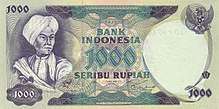 |
 |
1000 rupiah | 158 × 79 mm | Purple | Diponegoro at left, facing right | Buffalo ploughing rice field | Gajah Mada | Rachmat Saleh (Governor), Soeksmono. B. Martokoesoemo (Director) | '1975' | 1 June 1976 | 1 July 1980 | Undated specimens exists; issued note dated '1975' | ||
 |
 |
5000 rupiah | Red-brown | Fisherman | 3 Sailing Ships | Tjut Njak Dhien | 5 October 1976 | 1 March 1982 | Identical to unissued 'Diponegoro' note, except Diponegoro replaced with fisherman | |||||
 |
 |
10,000 rupiah | Green, brown and orange | Ramayana frieze at Borobodur | Batara kala, Jago Temple | General Sudirman | 15 July 1976 | 2 January 1980 | 29 June 1979 | |||||
1979–1982: Banknote Series 4 of the new rupiah
The first note to be replaced was again the top 10,000 rupiah note (by then worth approximately US$16), in 1979. Further redesigned notes followed in all denominations except the 100 rupiah, in 1980 and 1982.
| Rupiah notes '1979', '1980', '1982', printed by Perum Peruri | |||||||||||||
| Image | Value | Dimensions | Main Colour | Description | Date of | ||||||||
| Obverse | Reverse | Obverse | Reverse | Watermark | Signatures | Serial | note | issue | withdrawal | replacement | |||
| 500 rupiah | 140 × 68 mm | Green | Titan arum | Bank Indonesia building | Ahmad Yani | Rachmat Saleh, Durmawel Achmad | 3 letters, six numbers | '1982' | 1 December 1982 | 28 December 1992 | 29 January 1988 | ||
 |
 |
1000 rupiah | 145 × 72 mm | Blue | Soetomo | Sianok Valley | Hasanuddin | '1980' | 1 July 1980 | 30 June 1987 | |||
 |
 |
5000 rupiah | 153 × 76 mm | Brown | Diamond cutter, Kalimantan | 3 Toraja houses | Dewi Sartika | '1980' | 1 March 1982 | 9 December 1986 | |||
 |
 |
10,000 rupiah | 144 × 79 mm | Purple | Gamelan players, Central Java | Prambanan temple | Soetomo | Rachmat Saleh, Arifin M. Siregar | '1979' | 29 June 1979 | 27 December 1985 | ||
1985–1988: Banknote series 5 of the new rupiah
The 100 rupiah note dating from 1977 was finally replaced in 1985; replacement notes of all denominations followed in 1985, 1987 and 1988.
| Rupiah notes '1984', '1985', '1986','1987','1988', printed by Perum Peruri | |||||||||||||
| Image | Value | Dimensions | Main Colour | Description | Date of | ||||||||
| Obverse | Reverse | Obverse | Reverse | Watermark | Signatures | Serial | note | issue | withdrawal | replacement | |||
| 100 rupiah | 133 × 64 mm | Pink | Victoria crowned pigeon | Asahan dam | Garuda Pancasila | Arifin M. Siregar, Sujitno Siswowidagdo | 3 letters, six numbers | '1984' | 1 February 1985 | 28 December 1992 | |||
| 500 rupiah | 140 × 68 mm | Green | Rusa deer | Bank Indonesia building, Cirebon | Ahmad Yani | '1988' | 29 January 1988 | ||||||
| 1000 rupiah | 145 × 72 mm | Blue | Sisingamangaraja XII | Kraton Yogyakarta | Sultan Hasanuddin | '1987' | 30 June 1987 | ||||||
| 5000 rupiah | 153 × 76 mm | Brown | Teuku Umar | Minaret of Menara Kudus Mosque | Martha Christina Tiahahu | '1986' | 9 December 1986 | ||||||
 |
 |
10,000 rupiah | 144 × 79 mm | Purple | Kartini with Prambanan temple | Female university graduate, Indonesian flag | Tjipto Mangunkusumo | '1985' | 27 December 1985 | ||||
1992: series six banknotes of the new rupiah
28 December 1992 saw a complete overhaul of all denominations of notes for the first time since 1968. In addition, a new top denomation, 20,000 rupiah note was added, with a US$ value of approximately $10 at the time. This was the first new denomination of the 'new rupiah' since the 10,000 rupiah had been issued in April 1970 (then worth about US$26). From this issue forwards, Indonesian notes have carried in small text in the note border the year of printing; the most conspicuous date on the note is still the date of authority (e.g., "Direksi 1992").
| Rupiah notes '1992' series, printed by Perum Peruri | |||||||||||||
| Image | Value | Dimensions | Main Colour | Description | Remarks | ||||||||
| Obverse | Reverse | Obverse | Reverse | Watermark | Signatures | Serial | issue | withdrawal | replacement | ||||
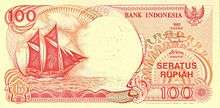 |
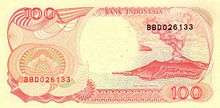 |
100 rupiah | 136 × 68 mm | Pink | Bugis phinisi | Krakatoa | Ki Hajar Dewantara | Adrianus Mooy (Governor), Sujitno Siswowidagdo (Director) | 3 letters, six numbers | 28 December 1992 | 30 November 2006 | Last of denomation | Carries imprint dates 1992–1996,1999,2000 |
 |
 |
500 rupiah | 140 × 68 mm | Green | Orangutan | East Kalimantan house | Omar Said Tjokroaminoto | Carries imprint date 1992–1999 | |||||
 |
 |
1000 rupiah | 144 × 68 mm | Blue | Lake Toba | Stone jumping, Nias | Cut Nyak Meutia | Adrianus Mooy (Governor), Hendrobudiyanto (Director) | 29 November 2000 | Carries imprint date 1992–2000 | |||
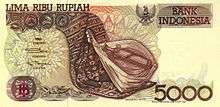 |
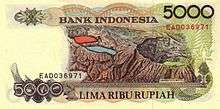 |
5000 rupiah | 145 × 72 mm | Brown | Sasando Rote | Tri-coloured lake, Kelimutu | Adrianus Mooy (Governor), Hasudungan Tampubolon (Director) | 6 November 2001 | Carries imprint date 1992–2001 | ||||
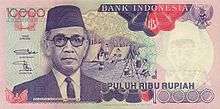 |
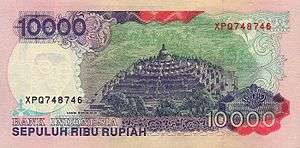 |
10,000 rupiah | 150 × 73 mm | Purple | Hamengkubuwono IX, Scouts camping | Borobodur | Wage Rudolf Supratman | Adrianus Mooy (Governor), R. Rachmad (Director) | 21 August 2000 | 18 February 1998 | Carries imprint date 1992–1998 | ||
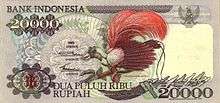 |
 |
20,000 rupiah | 152 × 72 mm | Green | Red bird-of-paradise | Clove flower, map of Indonesia | Ki Hajar Dewantara | Adrianus Mooy (Governor), Binhadi (Director) | 28 August 1995 | Carries imprint dates 1992–1995 | |||
1993: Suharto commemorative 50,000 rupiah
In 1993 a 50,000 rupiah (approx US$22) note celebrating "25 Years of Development" in polymer with hologram, limited to five million, and in a presentation pack explaining the 25-year growth plan since 1969 were printed, priced at double face value: 100,000 rupiah. The design featured Suharto on the front and Soekarno-Hatta airport on the back, with a plane taking off to symbolise Indonesia's growth. However, it is believed that due to poor sales, that some of the polymer notes, minus the folder, were issued as regularly circulating money. A paper version of similar design was printed in 1993 and 1994.
| Rupiah notes Suharto '1993' | |||||||||||||
| Image | Value | Dimensions | Main Colour | Description | Remarks | ||||||||
| Obverse | Reverse | Obverse | Reverse | Watermark | Signatures | Serial | issue | withdrawal | replacement | ||||
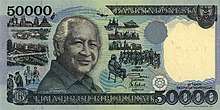 |
 |
50,000 rupiah | 152 × 76 mm | Blue | Suharto with scenes of industrial development, slogan "25 Tahun Indonesia Membangun" (25 years of Indonesia's development) | Garuda Indonesia Boeing 747 Aircraft taking off from Soekarno-Hatta International Airport | Wage Rudolf Supratman | Adrianus Mooy (Governor), TM Sjakur Machmud (Director) | 3 letters, 6 numbers | 1 February 1993 | 21 August 2000 | Last of denomation | Printed by state printers Perum Peruri, with imprint date 1993 or 1994 |
 |
 |
Suharto hologram, Bank Indonesia watermark | Adrianus Mooy (Governor), Hasudungan Tampubolon (Director) | Plastic note, printed by Note Printing Australia | |||||||||
1995: addition of security thread to top 1992/1993 banknotes
1995 saw the introduction of the security thread to Indonesian banknotes, a feature on all large (10,000 and above) notes of 'Direksi 1995' and newer. The 1992 20,000 rupiah, and 1993 paper 50,000 notes were the affected notes.
| Rupiah notes 1995 security thread updates, printed by Perum Peruri | |||||||||||||
| Image | Value | Dimensions | Main Colour | Description | Remarks | ||||||||
| Obverse | Reverse | Obverse | Reverse | Watermark | Signatures | Serial | issue | withdrawal | replacement | ||||
 |
 |
20,000 rupiah | As 1992 note | As 1992 + security foil strip | J. Soedradjad Djiwandono, Heru Soepraptomo (20,000 rupiah) J. Soedradjad Djiwandono, Boediono (50,000 rupiah) |
3 letters, 6 numbers | 28 August 1995 | 21 August 2000 | 23 January 1998 | Imprint dates 1995–1998 | |||
 |
 |
50,000 rupiah | As 1993 note (paper) | 1 June 1999 | |||||||||
Updates to high denominations; introduction of 100,000 rupiah note
The high denomination notes, 10,000, 20,000 and 50,000 rupiah were replaced in 1998 and 1999. A new polymer 100,000 rupiah note (by then only worth about US$10) was also added, imported from Australia. These notes, which were no longer printed following the introduction of new designs in 2004–2005, are no longer legal tender since 31 December 2008, although they remained exchangeable at Bank Indonesia offices until 30 December 2018.[14]
| Rupiah notes '1998', '1999' series | ||||||||||||||||
| Image | Value | Dimensions | Main Colour | Description | Date of | Remarks | ||||||||||
| Obverse | Reverse | Obverse | Reverse | Watermark | Signatures | Printer | Serial | issue | note series | first of denomination | replacement | withdrawal | ||||
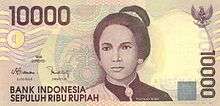 |
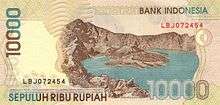 |
10,000 rupiah | 148 × 72 mm | Brown, gray | Tjut Njak Dhien | Lake Segara Anak | Wage Rudolf Soepratman; security thread | J. Soedradjad Djiwandono, Mukhlis Rasyid (10,000 rupiah). J. Soedradjad Djiwandono, Haryono (20,000 rupiah) |
Perum Peruri | 3 letters, 6 numbers | 18 February 1998 | '1998' | 1964 | 18 October 2005 | 31 December 2008 | Carries imprint date 1998–2005 |
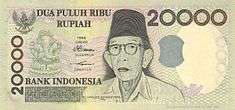 |
 |
20,000 rupiah | 152 × 72 mm | Green | Ki Hadjar Dewantara, Ganesha | Teacher and children in classroom | Ki Hadjar Dewantara; security thread | 19 February 1998 | 1992 | 29 December 2004 | ||||||
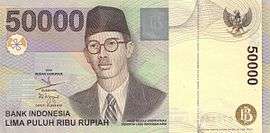 |
 |
50,000 rupiah | Gray, green | WR Soepratman | Indonesian flag hoist ceremony, 17 August 1997 | Omar Said Tjokroaminoto; security thread | Syahril Sabirin (Governor), Dono Iskandar Djojosoebroto (Deputy Governor) (1999). | 1 June 1999 | '1999' | 1993 | 18 October 2005 | Carries imprint dates 1999–2005 | ||||
| 100,000 rupiah | 151 × 65 mm | Red, brown, green, and blue | Sukarno and Hatta, proclamation of independence | Indonesian Parliament building, Jakarta | Garuda Pancasila and the logo of Bank Indonesia ; security thread | Syahril Sabirin (Governor), Iwan R. Prawiranata (Deputy Governor) | Note Printing Australia; Note Printing Works Bank of Thailand | 1 November 1999 | First of denomination | 31 December 2004 | No imprint date; phosphorus number for security | |||||
| These images are to scale at 0.7 pixel per millimetre. For table standards, see the banknote specification table. | ||||||||||||||||
Current series
Low denomination notes, 2000 and 2001
The lower denominations, 1,000 and 5,000 rupiah were updated in 2000 and 2001. While the 5,000 rupiah note is still being printed, the 1,000 rupiah note was last issued dated 2013 and, while remaining in circulation, has largely been replaced by a coin of the same value. The previous lowest denominations, 100 and 500 rupiah, no longer exist, since the rupiah had fallen in value by 80% since the previous issue of these denominations in 1992.
| Rupiah notes '2000', '2001' series, Printed by Perum Peruri | ||||||||||||||
| Image | Value | Dimensions | Main Colour | Description | Date of | Remarks | ||||||||
| Obverse | Reverse | Watermark | Signatures | Serial | note series | issue | note series | first of denomination | replacement | |||||
%2C_processed%2C_obverse%2Breverse.jpg) |
1000 rupiah | 141 × 65 mm | Blue and Purple | Captain Pattimura | Maitara and Tidore Islands, with fishermen on a boat | Tjut Njak Meutia | Anwar Nasution (Senior Deputy Governor), Aulia Pohan (Deputy Governor) |
Perum Peruri | 3 letters, 6 numbers | 29 November 2000 | '2000' | 20 February 1967 | 19 December 2016 | Carries imprint date 2000–2013 and 2016 |
%2C_processed%2C_obverse_and_reverse.jpg) |
5000 rupiah | 143 × 65 mm | Red and Green | Tuanku Imam Bonjol | Songket weaver, Tanah Datar | Syahril Sabirin (Governor), Miranda S. Goeltom (Deputy Governor) |
6 November 2001 | '2001' | 2 April 1970 | Carries imprint date 2001–2016 | ||||
2004/2005 high denomination note updates
The 10,000 – 100,000 notes were replaced in 2004 and 2005, with the 100,000 reverting to a locally printed paper design, as the polymer notes proved difficult for bank machines to count; all the notes were given better anti-forgery devices.
| Rupiah notes '2004', '2005' series, Printed by Perum Peruri | ||||||||||||
| Image | Value | Dimensions | Main Colour | Description | Date of | Remarks | ||||||
| Obverse | Reverse | Obverse | Reverse | Watermark | Signatures | Serial | note series | issue | ||||
| 10,000 rupiah | 145 × 65 mm | Pink | Sultan Mahmud Badaruddin II | The traditional Limas House of Palembang, South Sumatra | Sultan Mahmud Badaruddin II | Burhanuddin Abdullah (Governor), Bun Bunan E.J. Hutapea (Deputy Governor) | 3 letters, 6 numbers | '2005' | 18 October 2005 | Imprint 2005–2008 | ||
| 20,000 rupiah | 147 × 65 mm | Green | Oto Iskandar di Nata | Tea plantation, West Java | Otto Iskandar Di Nata | Burhanuddin Abdullah (Governor), Maulana Ibrahim (Deputy Governor) | '2004' | 29 December 2004 | Imprint 2004–2008 | |||
| 50,000 rupiah | 149 × 65 mm | Blue | I Gusti Ngurah Rai | Pura Ulun Danu Bratan, Bali | I Gusti Ngurah Rai | Burhanuddin Abdullah (Governor), Maman H. Soemantri (Deputy Governor) | '2005' | 18 October 2005 | Imprint 2005–2008 | |||
| 100,000 rupiah | 151 × 65 mm | Red | As 1999 issue | WR Supratman | Burhanuddin Abdullah (Governor), Aulia Pohan (Deputy Governor) | '2004' | 29 December 2004 | Imprint 2004–2008 | ||||
| These images are to scale at 0.7 pixel per millimetre. For table standards, see the banknote specification table. | ||||||||||||
New 2,000 rupiah note
After several delays, following an initial announcement that the 2000 rupiah note would replace the 1000 rupiah as lowest denomination, the new denomination, 2000 rupiah was finally officially released, to circulate alongside the lower denomination, in July 2009.
| Rupiah notes '2009' series, Printed by Perum Peruri | ||||||||||||
| Image | Value | Dimensions | Main Colour | Description | Date of | Remarks | ||||||
| Obverse | Reverse | Watermark | Signatures | Serial | note series | issue | ||||||
%2C_processed%2C_obverse%2Breverse.jpg) |
2000 rupiah | 141 x 65 mm | Grey | Prince Antasari of Banjar | Dayak traditional dance | Prince Antasari | Miranda Goeltom (Senior Deputy Governor) Budi Rochadi (Deputy Governor) |
3 letters, 6 numbers | '2009' | 9 July 2009 | Imprint 2009–2016 | |
Revised 10,000 rupiah note
On 20 July 2010, the 2005 issue 10,000 rupiah note was revised, featuring the same theme but with a colour change to better distinguish it from the 100,000 rupiah note. Several changes were also made to the note's security features and devices.
| Rupiah notes '2010', Printed by Perum Peruri | ||||||||||||
| Image | Value | Dimensions | Main Colour | Description | Date of | Remarks | ||||||
| Obverse | Reverse | Watermark | Signatures | Serial | note series | issue | ||||||
%2C_processed%2C_obverse%2Breverse.jpg) |
10,000 rupiah | 145 × 65 mm | Purple | Sultan Mahmud Badaruddin II | The traditional Limas House of Palembang, South Sumatra | Sultan Mahmud Badaruddin II | Darmin Nasution (Senior Deputy Governor) Muliaman D. Hadad (Deputy Governor) |
3 letters, 6 numbers | '2010' | 20 July 2010 | Imprint 2010–2016 | |
Revised 20,000, 50,000, and 100,000 rupiah notes
On 1 August 2011, in commemoration of Youth Pledge Day, Bank Indonesia issued newly designed banknotes denominated in 20,000-, 50,000-, and 100,000-rupiah, although they bear no special commemorative text or images. The new notes have enhanced security features including rainbow printing and new codes for the sight impaired.[15]
| Rupiah notes '2011', Printed by Perum Peruri | ||||||||||||
| Image | Value | Dimensions | Main Colour | Description | Date of | Remarks | ||||||
| Obverse | Reverse | Watermark | Signatures | Serial | note series | issue | ||||||
%2C_processed%2C_obverse%2Breverse.jpg) |
20,000 rupiah | 147 × 65 mm | Green | Oto Iskandar di Nata | Tea plantation, West Java | Otto Iskandar Di Nata | Darmin Nasution (Governor), Halim Alamsyah (Deputy Governor) | Imprint 2011–2016 | ||||
%2C_processed%2C_obverse%2Breverse.jpg) |
50,000 rupiah | 149 × 65 mm | Blue | I Gusti Ngurah Rai | Pura Ulun Danu Bratan, Bali | I Gusti Ngurah Rai | Darmin Nasution (Governor), Hartati Sarwono (Deputy Governor) | Imprint 2011–2016 | ||||
%2C_processed%2C_obverse%2Breverse.jpg) |
100,000 rupiah | 151 × 65 mm | Red | As 1999 issue | Wage Rudolf Supratman | Darmin Nasution (Governor), Ardhayadi Mitroatmodjo (Deputy Governor) | Imprint 2011–2014 | |||||
Revised 100,000 rupiah notes of 2014
Indonesia issued a revised 100,000 rupiah note on Independence Day, 17 August 2014. The banknotes have "Negara Kesatuan Republik Indonesia" ("The Unitary State of the Republic of Indonesia") written on the notes, replacing the name of its current issuer, Bank Indonesia. The new notes retain the images of its national figures and have more golden colors. It was purposely designed to make counterfeit harder.[16][17] The revised note carries an imprint of TE. (abbreviation of "Tahun Emisi", Issue Year) 2014 and the signatures of the then-BI governor Agus Martowardojo and the then-Indonesian Finance Minister Chatib Basri.
2016 series
Bank Indonesia introduced a new family of banknotes on 19 December 2016 in denominations of 1,000-, 2,000-, 5,000-, 10,000-, 20,000-, 50,000 and 100,000 rupiah. This series features national heroes from the history of Indonesia.[18]
| Rupiah notes '2016' series, Printed by Perum Peruri | ||||||||||||
| Image | Value | Dimensions | Main Colour | Description | Date of | Remarks | ||||||
| Obverse | Reverse | Obverse | Reverse | Watermark | Signatures | Serial | note series | issue | ||||
 |
 |
1,000 rupiah | 141 × 65 mm | Yellow-Grey | Tjut Meutia | Tifa dance and Banda Neira | Tjut Meutia | Sri Mulyani Indrawati (Finance Minister), Agus Martowardojo (Governor) | 3 letters, 6 numbers | '2016' | 19 December 2016 | Imprint 2016– |
 |
 |
2,000 rupiah | Grey | Mohammad Husni Thamrin | Piring dance and Sianok Canyon | Pangeran Antasari | ||||||
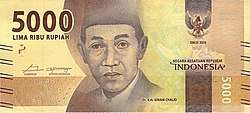 |
 |
5,000 rupiah | 143 × 65 mm | Brown | Idham Chalid | Gambyong dance and Mount Bromo | Tjut Meutia | |||||
 |
 |
10,000 rupiah | 145 × 65 mm | Purple | Frans Kaisiepo | Pakarena dance and Wakatobi National Park | Sultan Mahmud Badaruddin II | |||||
 |
 |
20,000 rupiah | 147 × 65 mm | Green | G.S.S.J. Ratulangi | Gong dance and Derawan Islands | Otto Iskandar Di Nata | |||||
 |
 |
50,000 rupiah | 149 × 65 mm | Blue | Djuanda Kartawidjaja | Legong dance and Komodo National Park | I Gusti Ngurah Rai | |||||
 |
 |
100,000 rupiah | 151 × 65 mm | Red | Sukarno and Mohammad Hatta | Topeng Betawi dance and Raja Ampat Islands | Wage Rudolf Supratman | |||||
| These images are to scale at 0.7 pixel per millimetre. For table standards, see the banknote specification table. | ||||||||||||
Security features
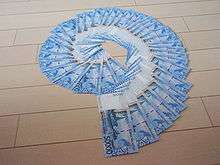
- The materials of the banknotes basically are long fibres from any kind of wood, or a mix of different types of wood. However, the preferable material is the abacá fibre, which is naturally plentiful in Indonesia and is believed to increase the durability of the banknotes. The banknotes are made with the process of heating, to create a unique type of pulp.
- The minimum security features for naked eyes are watermarks, electrotypes and security threads with colour fibres. In addition to this, extra features may be included, such as holograms, Irisafe, iridescent stripes, clear windows, metameric windows and gold patches.
- Watermark and electrotype are made by controlling the gap of density of the fibres which create certain images for the banknotes. This is done to raise the quality of the notes from the aesthetic view.
- Security threads are put in the middle of the note's materials so horizontal and vertical lines are shown from top to bottom. The threads also can be made with many variations such as the materials, size, colour and design.
- The 2010 10,000 rupiah, 2011 20,000, 50,000 and 100,000 rupiah introduced several new security features: use of EURion constellation rings, rainbow printing designed to change colour when viewed from different angles, and tactile features for blind people and those with visual difficulties to recognise the different denominations stated on the notes.
Notes
- Cuhaj, 2010, p.877.
- Cuhaj, 2010, pp. 878–886.
- Cuhaj, 2010, p. 697.
- Cuhaj, 2010, p. 699.
- Cuhaj, 2010, pp. 699–700.
- Cuhaj, 2010, pp. 700–701.
- BI.go.id
- Cuhaj, 2010, p. 701.
- Cuhaj, 2010, pp. 885–886.
- Cuhaj, 2010, p. 701.
- BI.go.id Archived 29 March 2008 at the Wayback Machine
- BI.go.id
- Liputan6.com (31 July 2020). "6 Potret Pecahan Rupiah yang Tak Berlaku Lagi pada 2021". liputan6.com (in Indonesian). Retrieved 6 August 2020.
- antaranews.com (25 June 2018). "Pecahan uang lama ditarik, batas penukaran 30 Desember". Antara News. Retrieved 6 August 2020.
- Indonesia new 20,000-, 50,000-, and 100,000-rupiah notes confirmed BanknoteNews.com. Retrieved 12 March 2012.
- BI Planning to Issue New Banknotes on August 2014 Tempo (www.tempo.co). 19 June 2014. Retrieved 2 July 2014.
- Indonesia new 100,000-rupiah note reported BanknoteNews.com. 19 August 2014. Retrieved 19 August 2014.
- Indonesia unveils new banknote family Banknote News (banknotenews.com). 20 December 2016. Retrieved 21 December 2016.
References
- Cuhaj, George S. (2010). Paper Money General Issues 1368–1960 (13 ed.). Krause Publications. ISBN 978-1-4402-1293-2.